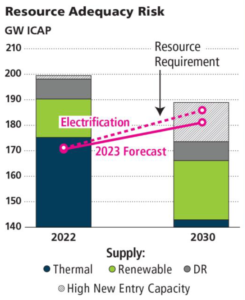 In a recently released report, PJM, a regional transmission organization (RTO) that coordinates the movement of wholesale electricity in all or parts of 13 states and the District of Columbia, said it would not be able to maintain an adequate level of generation resources.
In a recently released report, PJM, a regional transmission organization (RTO) that coordinates the movement of wholesale electricity in all or parts of 13 states and the District of Columbia, said it would not be able to maintain an adequate level of generation resources.
The analysis showed that 40 GW of existing generations are at risk of retirement by 2030. This figure is composed of: 6 GW of 2022 deactivations, 6 GW of announced retirements, 25 GW of potential policy-driven retirements, and 3 GW of potential economic retirements. Combined, this represents 21% of PJM’s current installed capacity.
In addition to the retirements, PJM’s long-term load forecast shows demand growth of 1.4% per year for the PJM footprint over the next 10 years.
On the other side of the balance sheet, PJM’s New Services Queue consists primarily of renewables (94%) and gas (6%). Despite the sizable nameplate capacity of renewables in the interconnection queue (290 GW), the historical rate of completion for renewable projects has been approximately 5%. The projections in this study indicate that the current pace of new entry would be insufficient to keep up with expected retirements and demand growth by 2030.
Of that 40 GW of retirements by 2030, 60% would be coal, 30% natural gas, and 10% other. Electrical load growth is forecast to be 13 GW by 2030 and beyond.
For the first time in recent history, PJM said it could face decreasing reserve margins should these trends continue. The amount of generation retirements appears to be more certain than the timely arrival of replacement generation resources and demand response, given that the quantity of retirements is codified in various policy objectives, while the impacts on the pace of new entry of the Inflation Reduction Act, post-pandemic supply chain issues, and other externalities are still not fully understood.




